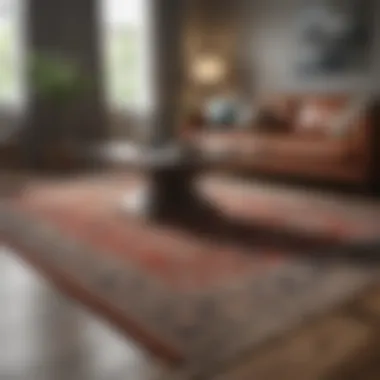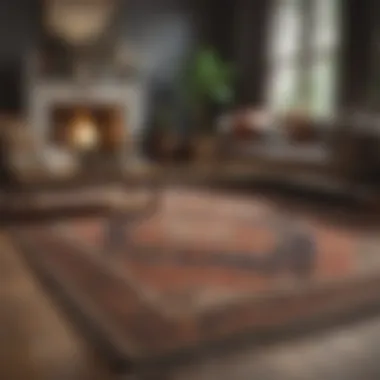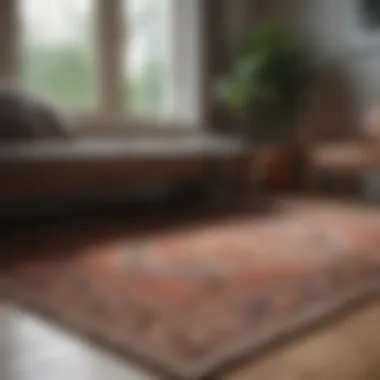Enhance Your Small Living Room with Strategic Rug Placement Techniques


Interior Design Tips
Trendy Design Ideas
Incorporating trendy design ideas into small living room rug placement can elevate the space to new heights. Opting for modern and minimalistic rug designs can create a sense of openness and airiness in the room, making it appear larger than it actually is. Additionally, experimenting with geometric patterns or bold colors can add a touch of personality and flair to the space, enhancing its visual appeal. By staying up to date with the latest design trends, homeowners can make informed decisions about rug placement that align with contemporary aesthetics.
Color Schemes and Combinations
Choosing the right color scheme and combinations for small living room rugs is essential in creating a harmonious and visually pleasing environment. Lighter hues such as beige, cream, or pale grey can help open up the space and create a sense of expansiveness, making the room feel brighter and more spacious. On the other hand, darker colors like navy blue or charcoal grey can add depth and sophistication to the room, creating a cozy and intimate atmosphere. By carefully selecting colors that complement the existing decor and furniture, homeowners can achieve a cohesive and well-balanced look that ties the room together.
Furniture Arrangement Techniques
In small living rooms, furniture arrangement plays a crucial role in optimizing rug placement. Placing the rug underneath the key furniture pieces such as the sofa or coffee table can anchor the space and create a sense of unity. Ensure that the rug extends beyond the furniture legs to define the seating area and add a layer of comfort and visual interest. Experimenting with different furniture arrangements can help maximize space utilization and create a balanced and harmonious layout that enhances the overall aesthetic appeal of the room.
Introduction
Rugs play a vital role in the aesthetics and functionality of a living space, especially in small rooms where every inch matters. The placement of rugs can have a significant impact on how the room looks and feels, affecting space perception, design cohesion, and functionality. By optimizing the placement of rugs in small living rooms, individuals can enhance the overall appeal of the space and make it more inviting.
Understanding the Importance of Rug Placement
Rug placement is not just about aesthetics; it is a strategic decision that can transform the entire look and feel of a room. Proper rug placement can create a sense of balance and harmony in the room, tying together different elements of the decor. It can also help define specific areas within the room, such as a seating area or a dining space.
Overview of Small Living Room Challenges
Small living rooms present unique challenges when it comes to rug placement. Limited space means that every design choice must be carefully considered to maximize functionality without overwhelming the room. One of the key challenges is finding the right balance between adding visual interest with a rug and avoiding overcrowding the space. Additionally, in a small living room, the rug should not only complement the furniture but also help create the illusion of a larger space.
Strategic Placement Techniques


In this section, we will delve into the crucial aspect of Strategic Placement Techniques concerning the placement of rugs in small living rooms. Understanding the significance of correctly positioning rugs is paramount in optimizing space perception and design cohesion within a limited area. By focusing on specific elements such as rug size, room layout, and furniture placement, readers can elevate the aesthetic appeal and functionality of their living spaces through strategic rug positioning.
Centering the Rug
Benefits of Centering
The Benefits of Centering a rug play a pivotal role in the overall harmony and balance of a room. Centering a rug not only acts as a focal point but also helps in defining the seating area, creating a sense of symmetry, and enhancing the visual appeal of the space. It contributes significantly to the overall aesthetics of the room by grounding the furniture arrangement and adding a touch of elegance. The unique feature of Centering is its ability to unify different design elements and tie the room together seamlessly, making it a popular choice for small living rooms seeking a cohesive and well-structured look.
Step-by-Step Centering Guide
The Step-by-Step Centering Guide provides a structured approach to achieving proper rug alignment within a confined space. By following this guide, readers can ensure that the rug is positioned accurately in relation to the furniture layout, considering factors such as room dimensions, rug size, and visual balance. This guide helps in avoiding common mistakes such as placing the rug too far or too close to the furniture, thereby optimizing the spatial perception and functionality of the room. Its detailed steps and clear instructions make it a reliable resource for individuals looking to enhance their living room aesthetics through strategic rug placement.
Floating Rug Approach
Creating Visual Space
The Floating Rug Approach focuses on creating an illusion of visual space within a small living room. By allowing a portion of the flooring to be visible around the rug perimeter, this technique gives the impression of a larger area, making the room feel more spacious and open. This approach is beneficial for rooms with limited square footage as it prevents the space from appearing overcrowded, providing a breathable and light ambiance. Its unique feature lies in its ability to visually expand the room while adding a touch of sophistication and modernity to the interior design.
Implementation Tips
Implementation Tips accompany the Floating Rug Approach, offering practical advice on executing this design technique effectively. These tips encompass aspects such as rug size selection, furniture placement coordination, and color scheme integration to enhance the overall visual impact. By following these recommendations, readers can successfully implement the Floating Rug Approach in their small living rooms, creating a harmonious and well-proportioned space that exudes elegance and contemporary flair.
Layering Rugs for Depth
Choosing Complementary Rugs
Choosing Complementary Rugs involves selecting rugs that harmonize with each other in terms of color, pattern, and texture. This technique adds depth and visual interest to the room while maintaining a cohesive design scheme. Complementary rugs complement each other's style and characteristics, creating a layered effect that enhances the overall aesthetic appeal of the space. The key characteristic of this approach is its versatility, allowing individuals to experiment with various rug combinations to achieve a personalized and well-curated look for their small living rooms.


Techniques for Layering
Techniques for Layering rugs offer guidance on how to layer rugs effectively to maximize depth and visual impact. By employing techniques such as overlap, juxtaposition, or size gradation, individuals can create multi-dimensional visual interest that elevates the room's design aesthetic. These techniques enable homeowners to play with different textures, colors, and patterns, adding sophistication and personality to their living spaces. The advantages of Techniques for Layering lie in their ability to add warmth, depth, and dimension to small living rooms, transforming them into inviting and stylish environments.
Size Considerations for Small Spaces
Selecting the Right Rug Size
Room Proportions Analysis
Room proportions analysis delves into the intricacies of how rug size can harmonize with the room's dimensions. By evaluating the length, width, and shape of the living room, one can strategically choose a rug size that complements the space. This analytical approach ensures that the rug neither dominates the room nor gets lost in the layout. Utilizing room proportions analysis as a foundation for rug selection guarantees a balanced and visually appealing living area.
Tips for Optimal Sizing
Tips for optimal sizing offer practical guidelines for selecting the right rug dimensions. Understanding the function of the rug in the room, considering the placement of furniture, and leaving appropriate margins along the walls are crucial aspects to contemplate. Optimal sizing tips also take into account the traffic flow in the area, ensuring that the rug's size enhances both the visual appeal and the practicality of the space. By adhering to these guidelines, one can elevate the aesthetic allure and spatial functionality of a small living room with finesse.
Maximizing Visual Expansion
Expanding visual perception within a small living room through strategic rug placement is a technique well worth exploring. By creating the illusion of more space than physically exists, the room can achieve a more open and inviting ambiance. Maximizing visual expansion through the careful selection and placement of rugs contributes to a harmonious and spacious living area that exudes elegance and style.
Illusion of Space
The illusion of space technique involves choosing rugs that have visually expanding properties. Opting for rugs with light colors, subtle patterns, and strategic placement can effectively make the room appear larger. By leveraging the psychology of visual perception, the illusion of space method simplifies and enhances the room's design scheme. This approach is a popular choice for small living rooms aiming to optimize space utilization and aesthetic appeal.
Sizing Chart Reference
A sizing chart reference serves as a valuable tool in determining the optimal rug size for a small living room. By referencing standard sizing charts based on room dimensions and furniture layouts, individuals can effortlessly navigate the realm of rug selection. This method streamlines the decision-making process and ensures that the chosen rug size aligns seamlessly with the room's proportions and design concept. Incorporating a sizing chart reference into the rug placement strategy elevates the visual cohesiveness and practicality of the living space with precision and elegance.


Design Harmony and Functional Integration
Design harmony and functional integration play a pivotal role in elevating the aesthetics and practicality of small living room spaces. By seamlessly blending rugs with furniture and decor elements, a sense of cohesion and balance is achieved, enhancing the overall ambiance. When considering design harmony, it is essential to focus on color and pattern coordination to create a cohesive look that ties the room together. Additionally, integrating furniture leg placement with rug positioning can optimize the visual flow and spatial organization within the room, ultimately contributing to a harmonious and functional living space.
Coordinating Rugs with Furniture
Color and Pattern Coordination
Color and pattern coordination is a crucial aspect of seamlessly merging rugs with furniture to establish a cohesive design scheme. By selecting rugs that complement the existing color palette and decor themes, a sense of unity and sophistication can be achieved. The careful selection of patterns that harmonize with the furniture style and overall room aesthetics can create visual interest and elevate the design impact. Utilizing color and pattern coordination in small living rooms enhances the perception of space and adds a touch of sophistication to the decor, making it a popular choice for creating a harmonious living area.
Furniture Leg Placement
Furniture leg placement is a key consideration when coordinating rugs with furniture in small living rooms. By ensuring that furniture legs either rest on or off the rug, the visual cohesion and spatial layout can be optimized. This technique helps define seating areas and pathways, creating a harmonious flow within the room. The strategic placement of furniture legs in relation to the rug not only enhances the overall design coherence but also contributes to the functionality and visual balance of the space. Incorporating furniture leg placement in rug coordination is advantageous for maximizing both aesthetic appeal and practicality in small living room setups.
Enhancing Comfort and Mobility
Padding and Underlay Importance
The importance of padding and underlay in rug placement cannot be overstated when aiming for enhanced comfort and mobility in small living rooms. By providing a supportive layer between the rug and floor, padding adds cushioning, reduces slippage, and prolongs the rug's lifespan. Underlay acts as a stabilizing agent, preventing shifting or bunching of the rug, thus optimizing safety and comfort. Incorporating high-quality padding and underlay enhances the tactile experience, improves sound insulation, and creates a luxurious feel underfoot for maximum comfort and stability in the living space.
Traffic Flow Optimization
Traffic flow optimization is essential for ensuring seamless movement within the small living room while maintaining a visually appealing layout. By strategically placing rugs along high-traffic areas and pathways, traffic flow can be directed efficiently, minimizing obstructions and enhancing the room's functionality. Aligning rug positioning with traffic patterns not only aids in optimizing space utilization but also contributes to the overall design coherence. Implementing traffic flow optimization through strategic rug placement facilitates easy navigation and fosters a sense of openness and airiness in the confined living area.
Maintenance and Cleaning Guidelines
Routine Care Practices
Incorporating routine care practices is fundamental in preserving the look and longevity of rugs in small living rooms. Regular vacuuming, rotating rugs, and addressing spills promptly are essential routines to maintain cleanliness and prevent wear and tear. Following manufacturer's guidelines for cleaning and maintenance can prolong the rug's lifespan and uphold its appearance over time. By establishing a consistent routine for rug care, homeowners can uphold the aesthetic appeal of their living area and ensure the longevity of their investment, providing a clean and inviting atmosphere for occupants.
Stain Removal Techniques
Effective stain removal techniques are crucial for addressing spills and maintaining the pristine condition of rugs in small living rooms. Promptly attending to spills with appropriate cleaning solutions and techniques can prevent stains from setting and damaging the rug fibers. Utilizing gentle yet effective stain removal methods tailored to the rug material and type of stain ensures successful and safe cleaning outcomes. Implementing proper stain removal techniques equips homeowners with the necessary skills to handle unforeseen accidents and preserve the rug's appearance, contributing to a well-maintained and visually appealing living space.







